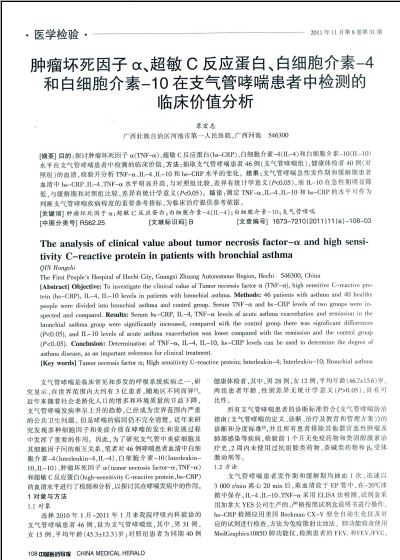肿瘤坏死因子α、超敏C反应蛋白、白细胞介素-4 和白细胞介素-10在支气管哮喘患者中检测的临床价值分析(1)
 |
| 第1页 |
参见附件(2433KB,3页)。
[摘要] 目的:探讨肿瘤坏死因子α(TNF-α)、超敏C反应蛋白(hs-CRP)、白细胞介素-4(IL-4)和白细胞介素-10(IL-10)水平在支气管哮喘患者中检测的临床价值。方法:抽取支气管哮喘患者46例(支气管哮喘组),健康体检者40例(对照组)的血清,检验并分析TNF-α、IL-4、IL-10和hs-CRP水平的变化。结果:支气管哮喘急性发作期和缓解期患者血清中hs-CRP、IL-4、TNF-α水平明显升高,与对照组比较,差异有统计学意义(P<0.05),而IL-10在急性期明显降低,与缓解期和对照组比较,差异有统计学意义(P<0.05)。结论:测定TNF-α、IL-4、IL-10和hs-CRP的水平可作为判断支气管哮喘疾病程度的重要参考指标,为临床治疗提供参考依据。
[关键词] 肿瘤坏死因子α;超敏C反应蛋白;白细胞介素-4(IL-4);白细胞介素-10;支气管哮喘
[中图分类号] R562.25 [文献标识码] B [文章编号] 1673-7210(2011)11(a)-108-03
The analysis of clinical value about tumor necrosis factor-α and high sensitivity C-reactive protein in patients with bronchial asthma
QIN Hongzhi
The First People's Hospital of Hechi City, Guangxi Zhuang Autonomous Region, Hechi 546300, China
[Abstract] Objective: To investigate the clinical value of Tumor necrosis factor α (TNF-α), high sensitive C-reactive protein (hs-CRP), IL-4, IL-10 levels in patients with bronchial asthma. Methods: 46 patients with asthma and 40 healthy people were divided into bronchial asthma and control group. Serum TNF-α and hs-CRP levels of two groups were inspected and compared. Results: Serum hs-CRP, IL-4, TNF-α levels of acute asthma exacerbation and remission in the bronchial asthma group were significantly increased, compared with the control group there was significant differences (P<0.05), and IL-10 levels of acute asthma exacerbation was lower compared with the remission and the control group (P<0.05). Conclusion: Determination of TNF-α, IL-4, IL-10, hs-CRP levels can be used to determine the degree of asthma disease, as an important reference for clinical treatment.
[Key words] Tumor necrosis factor α; High sensitivity C-reactive protein; Interleukin-4; Interleukin-10; Bronchial asthma
支气管哮喘是临床常见和多发的呼吸系统疾病之一,研究显示,在世界范围内大约有3亿患者,随地区不同而异[1]。近年来随着社会老龄化人口的增多和环境质量的日益下降,支气管哮喘发病率呈上升的趋势,已经成为世界范围内严重的公共卫生问题。但是哮喘的病因仍不完全清楚。近年来研究发现多种细胞因子和炎症介质在哮喘的发生和发展过程中发挥了重要的作用。因此,为了研究支气管中炎症细胞及其细胞因子问的相互关系,笔者对46例哮喘患者血清中白细胞介素-4(Interleukin-4,IL-4)、白细胞介素-10(Interleukin-10,IL-10)、肿瘤坏死因子α(tumor necrosis factor-α,TNF-α)和超敏C反应蛋白(high-sensitivity C-reactive protein ......
您现在查看是摘要介绍页,详见PDF附件(2433KB,3页)。